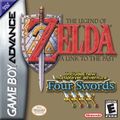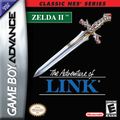| Don't like the ads? Then create an account! Users with accounts have more options than anonymous users. |
Game Boy Advance
| Game Boy Advance | |
|---|---|
 An original, white Game Boy Advance model | |
| Type | Handheld |
| Release dates | |
The Game Boy Advance is a 32-bit handheld console released by Nintendo in 2001. It is the successor of the Game Boy Color. The Game Boy Advance is backward compatible with both Game Boy and Game Boy Color games. In 2003, it received an upgraded version with a clamshell design and backlit screen, the Game Boy Advance SP. In 2005, another model was released, the Game Boy Micro, which dropped the clamshell design for a brick-like shape and does not feature backward compatibility with Game Boy and Game Boy Color games.
The Nintendo GameCube has a peripheral titled the Game Boy Player that allows Game Boy Advance games to be played on the GameCube. This can be done by inserting a Game Boy Advance cartridge into the Game Boy Player's cartridge slot. Just like the Game Boy Advance's original and SP variants, the Game Boy Player also supports Game Boy and Game Boy Color cartridges.
Games[edit]
Most The Legend of Zelda games for the Game Boy Advance consist of re-releases of earlier games. The two Nintendo Entertainment System games, The Legend of Zelda and Zelda II: The Adventure of Link were directly ported as individual releases for the Classic NES Series. The Super Nintendo Entertainment System title, The Legend of Zelda: A Link to the Past, was also ported but was only released on a compilation that also includes the exclusive multiplayer game, The Legend of Zelda: Four Swords. The compilation, titled The Legend of Zelda: A Link to the Past/Four Swords, was the first The Legend of Zelda-related release for the Game Boy Advance.
In the original Nintendo GameCube release of The Legend of Zelda: The Wind Waker, there is an item named the Tingle Tuner, which is designed after an original Game Boy Advance, with a green outer shell and yellow buttons. Differences in its design include the inverted A and B buttons and the top-center of the unit being in a pointed cone shape, akin to Tingle's pointed outfit, with an antenna on top. If Link has the Tingle Tuner, the player can optionally connect a Game Boy Advance to the GameCube by plugging the Nintendo GameCube–Game Boy Advance Link Cable into either of the controller ports 2–4. This way, Tingle can be controlled from the Game Boy Advance, where he helps Link during his adventure in various ways, such as to provide hints or by using an item.
The second The Legend of Zelda game to make use of the Link Cable is The Legend of Zelda: Four Swords Adventures. Its use is a lot more prominent than in The Legend of Zelda: The Wind Waker because it can be used as a controller option throughout the game. This option causes gameplay for interior locations to occur on the Game Boy Advance screen rather than on the GameCube.
Aside from The Legend of Zelda: Four Swords, the only other original The Legend of Zelda game for the handheld is The Legend of Zelda: The Minish Cap, which released around the end of the system's lifespan.
Gallery[edit]
Variants[edit]
-
A Game Boy Advance SP
-
A Game Boy Micro
Games[edit]
-
Classic NES Series: Zelda II: The Adventure of Link (2004)





